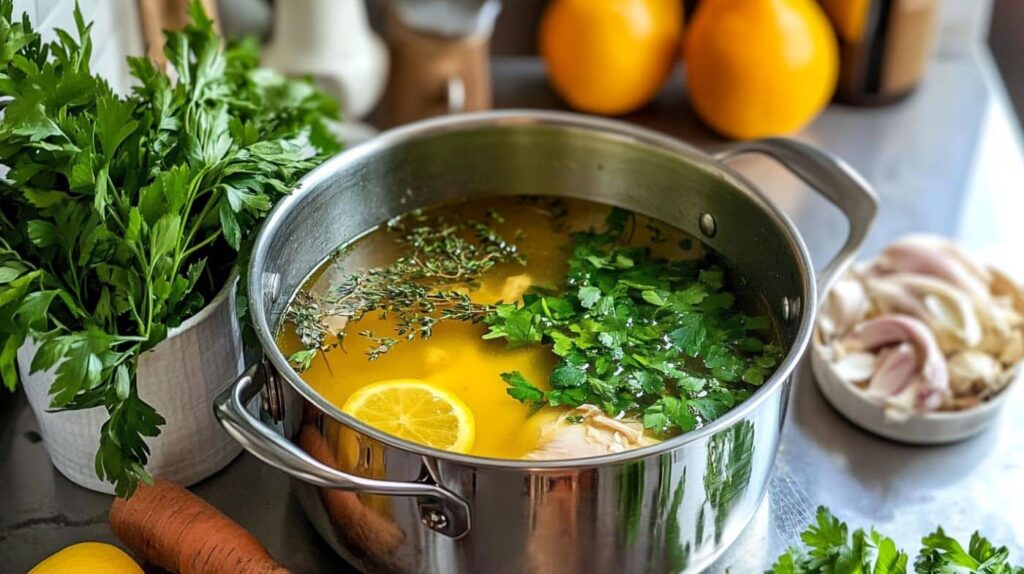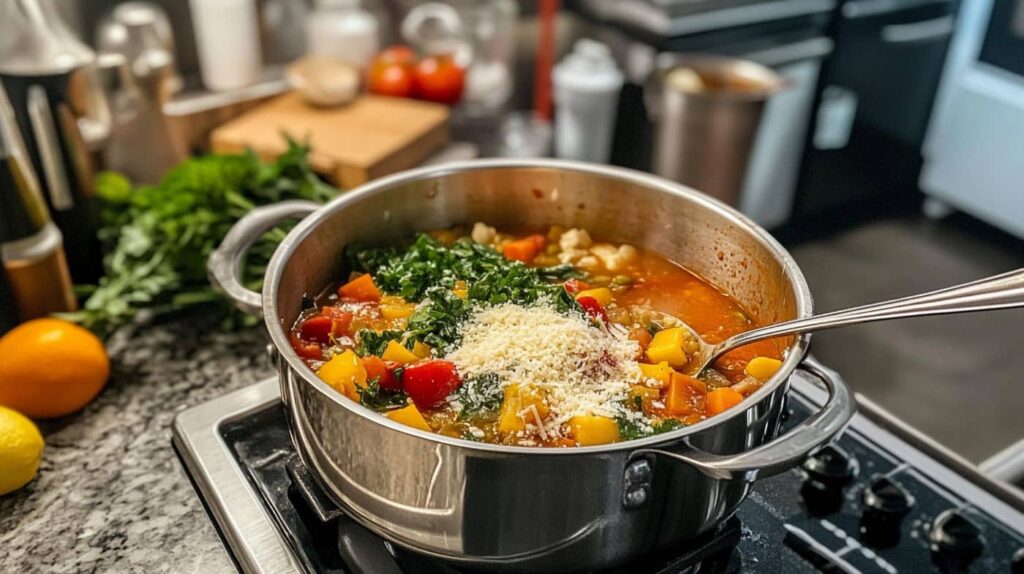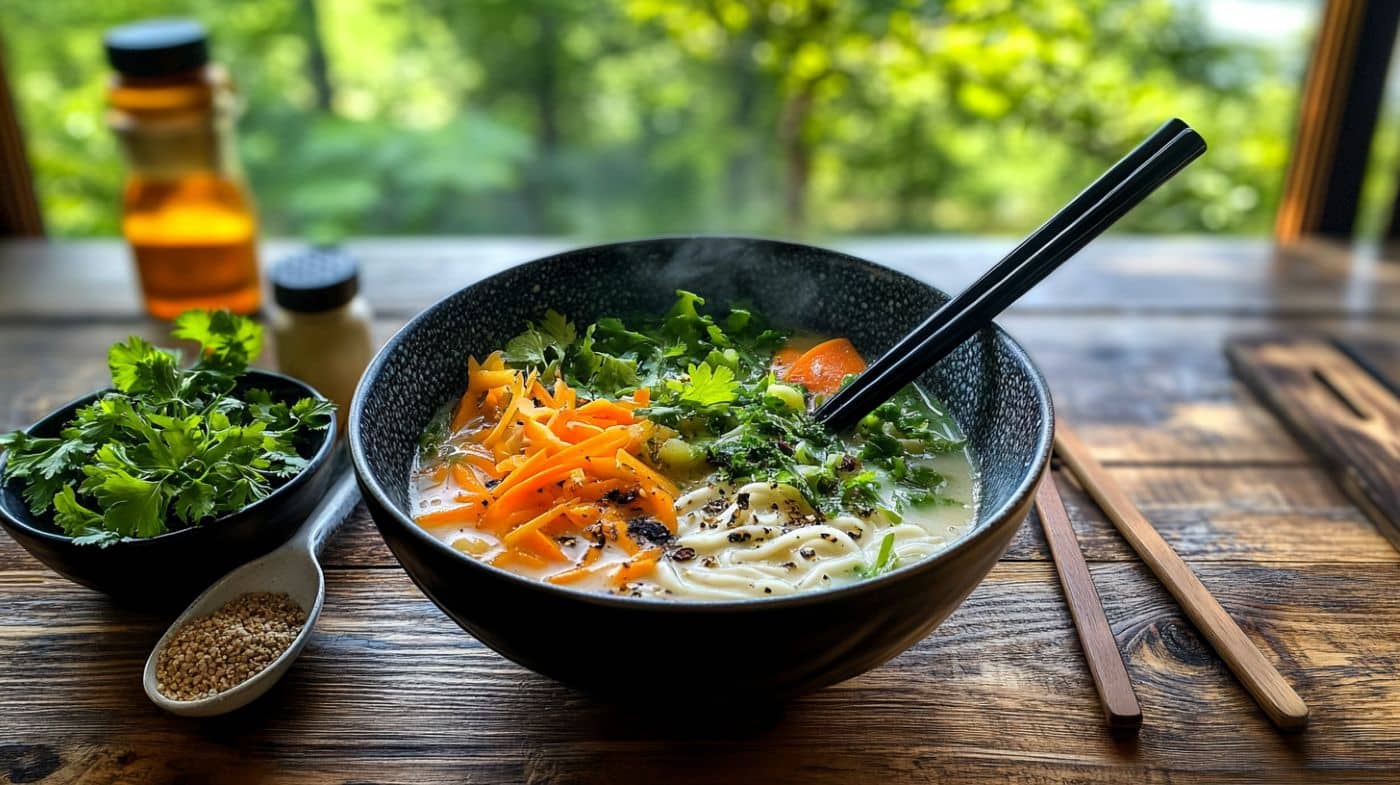Soup is one of those magical dishes that can warm your soul, brighten your day, and make your kitchen smell like home. But have you ever wondered, “What’s the secret ingredient that takes soup from good to absolutely unforgettable?” That’s what we’re diving into today. Stick around, and by the end of this article, you’ll have all the tools you need to create soup so good, it’ll taste like it has a pinch of magic. 🥣✨
Table of Contents
The Art of Soup-Making: Why Flavor Matters
Let’s face it: soup isn’t just food; it’s comfort in a bowl. Whether it’s a hearty chicken noodle or a creamy tomato bisque, the flavor is what truly makes it shine. But here’s the kicker—creating that perfect flavor isn’t always easy.
Have you ever made a soup that tasted flat, like it was missing something? Or maybe it was too salty or lacked balance? The secret to a great soup is layering flavors in just the right way. Think of it like building a house—you need a solid foundation before you can add the fancy details.
Common Challenges in Creating a Perfect Soup
Before we spill the beans (pun intended 😉) on secret ingredients, let’s talk about the roadblocks most people face when making soup.
Bland Tastes: The Most Common Problem
You’ve followed the recipe to the letter, but the soup tastes like… well, water. This is often because it’s missing depth. Depth comes from a combination of seasonings, broth, and—drumroll, please—the secret ingredient!
Overpowering Flavors: Finding Balance
On the flip side, have you ever added too much garlic or spice and ended up with a soup that made you sweat? Balance is key, and adding bold flavors sparingly is like sprinkling glitter—it’s all about just the right amount.
Texture Troubles: Too Thick or Too Thin
Soup texture is like the Goldilocks of cooking—it has to be just right. Too thick, and it feels like a stew; too thin, and it lacks body. This is why your choice of ingredients (and their proportions) is so important.
The Foundation of Soup: Essential Ingredients
Let’s get back to basics. Every great soup starts with a solid foundation, and these are the ingredients you can’t skip if you want something amazing.
The Role of Broth and Stock

Broth or stock is the heart and soul of your soup. Think of it like the canvas for a painting—it sets the tone for everything else. Chicken stock, beef broth, vegetable stock—they each bring their own unique flavor. For extra richness, simmer your stock with bones, vegetables, and herbs.
Pro Tip: “Homemade broth is like a warm hug for your taste buds. If you can spare the time, it’s worth it!”
Fresh Vegetables and Aromatics
Carrots, celery, onions—these aren’t just for show. Known as mirepoix in French cooking, this combo is the backbone of many soups. Add garlic, leeks, or shallots for extra flavor.
Choosing the Right Protein
Chicken, beef, tofu, beans… whatever your preference, the protein in your soup brings both substance and flavor. Browning your protein before adding it to the soup can take things to the next level.
The Science Behind Flavor Enhancement
Alright, here’s where things get fun. Did you know there’s actual science behind making your soup taste better? Let’s nerd out for a minute.
Umami: The Fifth Flavor
Umami is that deep, savory flavor that makes your mouth water. Foods like mushrooms, soy sauce, and Parmesan cheese are packed with it. Adding a touch of umami can instantly elevate your soup.
How Acidity Can Brighten Flavors
A splash of lemon juice, a dollop of yogurt, or a drizzle of vinegar can make a world of difference. Acidity cuts through the richness of your soup and brings out hidden flavors.
Fun Fact: “Chefs often say, ‘If your soup tastes dull, it probably needs a hit of acid.’” 🍋
The Impact of Herbs and Spices
Herbs and spices are like the jewelry of your soup—they add sparkle. Bay leaves, thyme, parsley, cumin, paprika… the list is endless. Don’t be afraid to experiment and find your signature combo.
Exploring the Secret Ingredient Concept
Now that we’ve covered the basics, let’s dig into the heart of the matter: secret ingredients. What makes something a “secret” ingredient anyway?
What Qualifies as a Secret Ingredient?
A secret ingredient isn’t just any random thing you throw in; it’s something unexpected yet transformative. It’s the twist that makes people ask, “What’s in this?”
Historical and Cultural Perspectives on Soup Secrets
Cultures around the world have their own “soup secrets.” In Japan, it might be miso paste. In Italy, Parmesan rinds. In the U.S., some people swear by a dash of hot sauce. These secrets often come from years of tradition and experimentation.
Popular Secret Ingredients from Around the World
Here’s where we get into the juicy part—specific secret ingredients that can turn your soup from average to extraordinary.

| Ingredient | Flavor Profile | Best Used In |
|---|---|---|
| Fish Sauce | Savory, umami | Brothy soups like pho |
| Miso Paste | Salty, earthy | Creamy soups or ramen |
| Parmesan Rinds | Nutty, cheesy | Italian-style soups |
| Wine or Vinegar | Tangy, complex | Rich stews and bisques |
Common Misconceptions About Soup Secrets
Let’s clear up a few myths about soup-making. Sometimes, what you don’t do is just as important as what you do.
Do All Soups Need a Secret Ingredient?
Here’s the truth: not every soup needs a “secret” to shine. Some soups, like classic chicken noodle or simple vegetable soup, rely on fresh ingredients and proper seasoning. Adding too many extras can overwhelm the natural flavors.
Balancing Complexity with Simplicity
The phrase “less is more” holds true in soup-making. A good secret ingredient complements your soup without stealing the show. Think of it like a supporting actor—it enhances the main performance, but it’s not the star.
How to Discover Your Own Secret Ingredient
You don’t need to follow trends to find the perfect secret ingredient. Sometimes, the best discoveries happen by accident—or through a bit of trial and error. Here’s how you can uncover your soup’s special touch.
Experimenting with Unconventional Additions
Ever thought about adding a dollop of peanut butter to your soup? Or maybe a sprinkle of cinnamon? Don’t be afraid to get creative. Some of the best secret ingredients are ones you wouldn’t normally associate with soup.
Quote: “Cooking is like a playground. Don’t be afraid to swing, slide, and see what works!” 🎢
Incorporating Seasonal and Local Ingredients
Using what’s fresh and local can inspire your secret ingredient. If it’s fall, try roasted pumpkin puree or apple cider vinegar. In summer, fresh basil or sweet corn might be your game-changer.
Tasting and Adjusting During Cooking
Your taste buds are your best guide. Start with small amounts of your chosen ingredient and build up slowly. Taste as you go—this ensures you don’t accidentally overpower your soup.
Tips to Enhance Your Soup’s Flavor Without a Secret Ingredient
Even if you don’t have a go-to secret ingredient, there are plenty of ways to level up your soup game. These simple tips can take your dish from ordinary to extraordinary.
Proper Seasoning and Timing
Seasoning isn’t just about adding salt and pepper; it’s about knowing when to add them. Salt should go in gradually as the soup cooks, while fresh herbs and spices often shine best when added at the end.
Fun Fact: “Salt doesn’t just make food salty—it actually enhances sweetness and balances bitterness.”
Building Layers of Flavor
Think of your soup like a story, with each ingredient adding its own chapter. Start by sautéing aromatics like onions and garlic, then layer in your vegetables, broth, and proteins. Each step builds complexity.
Letting the Soup Rest for Better Taste
Soup often tastes better the next day because the flavors have had time to meld. If you’re meal-prepping, try making your soup a day in advance for the ultimate flavor boost.
Pro Tip: “Soup is like wine—it gets better with age (well, up to a point!).” 🥂
Mistakes to Avoid When Adding a Secret Ingredient
Even the best cooks make mistakes, but when it comes to adding a secret ingredient, it’s important to tread carefully. A single misstep can turn your soup from a masterpiece into a mishap. Here are the most common pitfalls and how to avoid them.
Overpowering the Base Flavor
One of the biggest mistakes people make is letting the secret ingredient dominate the entire dish. For example, a tablespoon of fish sauce might add umami, but overdo it, and all you’ll taste is fish. The goal is to enhance, not overwhelm.
Tip: “Think of your secret ingredient as a whisper, not a shout. Subtlety is key.” 🎤
Adding Ingredients Too Late or Too Early
Timing matters in soup-making. Some ingredients, like fresh herbs, are best added at the end to preserve their delicate flavor. Others, like Parmesan rinds or bones, need time to release their goodness. Tossing them in at the wrong stage can throw off the balance.
Ignoring Dietary Restrictions or Preferences
Your secret ingredient might be brilliant, but it won’t win hearts if it doesn’t fit your audience. For instance, adding cream to a soup for a lactose-intolerant guest isn’t ideal. Always consider who you’re cooking for.
FAQs About “What is the Secret Ingredient in Soup?”
What is the most important ingredient in soup?
The most important ingredient in soup is broth or stock. It serves as the foundation for the dish, providing depth and a rich base of flavor. A well-made broth—whether it’s chicken, beef, vegetable, or seafood—can elevate the simplest ingredients into a harmonious and satisfying meal. Always aim for high-quality, homemade, or low-sodium store-bought options for the best results.
What is the secret to a good soup
The secret to a good soup lies in layering flavors. Start with aromatics like onions, garlic, and celery, then build with seasonings, quality broth, and fresh ingredients. Allow enough time for the ingredients to simmer and blend, and taste as you go to adjust seasoning. Adding a secret ingredient, like a splash of vinegar or a pinch of spice, can bring all the flavors together and make your soup unforgettable.
What is the secret ingredient in secret ingredient soup in Kung Fu Panda?
In Kung Fu Panda, the “secret ingredient” in Mr. Ping’s Secret Ingredient Soup is a beautiful metaphor—it’s nothing! The movie reveals that there is no magical ingredient; instead, the secret lies in belief, love, and confidence. This reinforces the idea that a dish becomes extraordinary through the care and effort of the person making it.
Why do chefs put vinegar in soup?
Chefs use vinegar in soup to balance flavors and add brightness. Acidity from vinegar can cut through rich, fatty ingredients and enhance the overall taste. It’s like a finishing touch that brings out the hidden nuances of the soup. Popular options include balsamic, white wine, or apple cider vinegar, depending on the type of soup.
Related Articles to Enhance Your Soup-Making Skills
Looking to expand your culinary skills and add even more flavor to your soup-making journey? Check out these related posts for inspiration and expert tips:
- Explore the delightful flavors of Marry Me Chicken Soup, a romantic dinner idea packed with hearty ingredients.
- Discover The Best Olive Garden Alfredo Sauce Recipe to learn how creamy sauces can add richness to your cooking.
- Uncover What is the Sauce Made Of for Birria Tacos and see how bold flavors can transform a dish.
- Learn What Makes Texas Chili Different to master the art of balancing spices and creating a robust, hearty meal.
These articles offer unique insights that can complement your soup-making techniques and inspire creativity in your kitchen! 🥣✨
Conclusion: Finding the True Secret Ingredient in Soup
So, what’s the ultimate secret ingredient in soup? After all this talk, here’s the real answer: it’s your creativity. Every great soup tells a story, and your secret ingredient is what makes that story uniquely yours.
The Secret Ingredient Is Your Creativity
There’s no universal formula for the perfect soup. It’s about experimenting, tasting, and finding what works for you. Whether it’s a splash of wine, a pinch of cinnamon, or even a family tradition, your soup should reflect your personality.
Why Soup-Making Is a Personal Journey
Soup is more than just a recipe—it’s an experience. It’s about the memories you create while stirring the pot, the joy of serving it to loved ones, and the pride of saying, “I made this.”
Quote: “The best soups aren’t found in cookbooks—they’re found in kitchens filled with love.”
Example Recipe: Vegetable Soup with a Secret Ingredient
Here’s a simple recipe to inspire your creativity. This vegetable soup includes a surprising twist: a splash of balsamic vinegar for a sweet and tangy kick.
Ingredients
| Ingredient | Quantity |
|---|---|
| Olive oil | 2 tbsp |
| Onion (chopped) | 1 large |
| Carrot (sliced) | 2 medium |
| Celery (diced) | 2 stalks |
| Zucchini (cubed) | 1 medium |
| Diced tomatoes (canned) | 1 can (400g) |
| Vegetable broth | 4 cups |
| Garlic (minced) | 2 cloves |
| Bay leaf | 1 |
| Thyme (dried) | 1 tsp |
| Balsamic vinegar | 1 tbsp |
| Salt and pepper | To taste |
Instructions
- Heat olive oil in a large pot over medium heat. Sauté onions, carrots, and celery until softened (about 5 minutes).
- Add garlic and thyme, cooking for another minute until fragrant.
- Stir in zucchini, diced tomatoes, vegetable broth, and the bay leaf. Bring to a boil, then reduce to a simmer.
- Cook for 20–25 minutes, stirring occasionally.
- Remove from heat and stir in balsamic vinegar. Season with salt and pepper to taste.
- Serve hot, and enjoy the unique flavor twist! 🥕🍅
Soup is more than just a meal—it’s an adventure. Now that you know how to find your own secret ingredient, go ahead and create a bowl of magic. Your kitchen is waiting! 🥣✨

